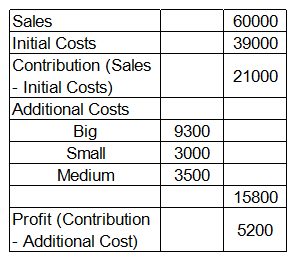1. In the diagram given below ‘D’ represents the depot and A, B, C are the retail outlets points such that the distance between ‘D’ and ‘A’ is 10 kms. ‘D’ and ‘B’ is 15 kms. and D and C is 20 kms. Distance from ‘A’ to ‘B’ is 5 kms and ‘B’ to ‘C’ is 7 kms. What is the saving in kms, if the route is optimised on any day and a vehicle has limit of 50 kms. per day and load wise it can pick up the the load of ‘A’, ‘B’ and ‘C’ in one loading:
Show Similar Question And Answers
 Each of the Big, Small and Medium cost is categorized by the manager into Red, Yellow, Green and Violet costs. Breakdown of the additional costs under these headings is shown in the table below:
Each of the Big, Small and Medium cost is categorized by the manager into Red, Yellow, Green and Violet costs. Breakdown of the additional costs under these headings is shown in the table below: Red, Yellow, Green and Violet costs are allocated to different retail formats. These costs are apportioned in the ratio of number of units consumed by each retail format. The number of units consumed by each retail format is given in the table below:
Red, Yellow, Green and Violet costs are allocated to different retail formats. These costs are apportioned in the ratio of number of units consumed by each retail format. The number of units consumed by each retail format is given in the table below: Read the following statements:
Statement I. Online store accounted for 50% of the sales at BnC and the ratio of supermarket sales and book store sales is 1:2.
Statement II. Initial Cost is allocated in the ratio of sales. If you want to calculate the profit/loss from the different retail formats, then....
Read the following statements:
Statement I. Online store accounted for 50% of the sales at BnC and the ratio of supermarket sales and book store sales is 1:2.
Statement II. Initial Cost is allocated in the ratio of sales. If you want to calculate the profit/loss from the different retail formats, then.... Powered By:Omega Web Solutions
Powered By:Omega Web Solutions